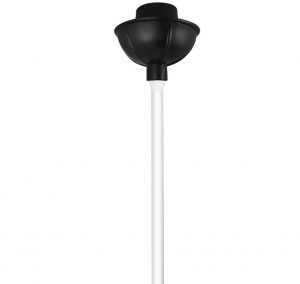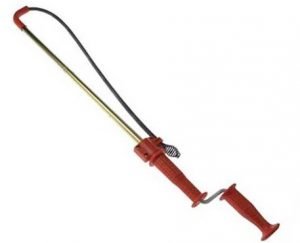How to Plunge a Toilet Like a Pro
Last Updated on August 3, 2023 by toilethaven
How Do You Unclog a Toilet Using a Plunger?
A toilet plunger is a handy piece of equipment to have, especially if you have kids in your house. Even if they don’t throw toys down the toilet, which they often do, they are likely to use too much toilet paper, which is responsible for most toilet clogs. Knowing how to plunge a toilet effectively can therefore save you a lot of time and money.
A toilet plunger will unclog a toilet 90% of the time. You, therefore, don’t need to call in a plumber every time you have a clogged toilet. A decent toilet plunger costs about 20 dollars, while a plumber would charge a minimum of 100 dollars.
- 2 in 1 : The product contains a high efficient toilet brush, a powerful toilet plunger and a two-compartment steady holder. Space saving stylish design and convenient storage, keep your bathroom neat,...
- HEAVY DUTY TOILET PLUNGER: Built with commercial grade rubber suction cup which provides maximum plunging power for clearing tough clogs of toilet bowl, shower drains and sinks. Ergonomic handle...
- HIGH EFFICIENT TOILET BOWL BRUSH: Strong bristles are not easy to get deformed, they are economical and practical, the dense nylon bristles offers thorough and deep cleaning of under-rim area and...
To properly plunge a toilet, first, make sure you are using a flange plunger and that the toilet bowl is about half full with water. Position the plunger on the bowl drain outlet and plunge gently to engage the plunger and then aggressively for 2 minutes.
Lift the plunger to see if water is draining out of the bowl. If not, repeat the process.
The wrong way to plunge a toilet is when you use a flat-bottomed plunger instead of a flange plunger and when you plunge the toilet without enough water in the bowl. Plunging the toilet when the bowl is full is also the wrong way to do it.
As such, if your toilet bowl is full of water or even overflowing, you may need to drain it first. This post explains how to drain a toilet.
A toilet may eventually unclog itself after some time if the clog is something that dissolves or breaks down in water, like toilet paper or soap. If, however, the clog is caused by a solid material like a towel, then the clog will not unclog itself.
To unclog a toilet when the plunger doesn’t work, use a toilet auger to break down or pull out the clog. If nothing seems to work, you can either pull out the toilet to remove the clog by hand, or you may decide to contact a professional plumber.
Which is the best plunger for unclogging a toilet?
There are 2 different types of plungers. One is flat-faced with a perfect circle like a ball cut in half. This type of plunger is effective in unclogging sink and bathtub drains but not toilets.

The best plunger for unclogging a toilet is bell-shaped. It has a small flange extending from the bigger circle. This makes it able to form a tight seal against the toilet bowl outlet.

A toilet plunger works by creating pressure and then a vacuum above the clog as you plunge down and up. When you plunge down, the pressure creates forces the clog down the drain, while when you plunge up, the vacuum creates forces the clog upwards.
A plunger is able to unclog a toilet if the clog is at the S-trap, but if the clog is way too deep in the drainpipe, it might be ineffective.
How to Properly Plunge a Clogged Toilet
Unlike a toilet auger, anybody can use a plunger to unclog a toilet without the risk of destroying the porcelain. Here is how to plunge a toilet and unclog it fast.
1. Drain the water in the bowl
When you have a clogged toilet, often the bowl will be full of water or even overflowing. There is also a possibility that the bowl contains poop and toilet paper.
As gross as it may look, you cannot plunge a toilet bowl that is full. The waste will splash on your face and bathroom floor. A plunger, unlike an auger, requires you to be very close to the bowl.
Use a cup to scoop and empty the water into a bucket until the level is at the half-full mark. Remember to have on your rubber gloves and slip-resistant shoes.
2. Bring on the Plunger
Slowly insert the plunger in the half-full toilet bowl and engage the flange to the bowl outlet. Give it an initial gentle plunge to make sure that it is tightly sealed in the bowl.
Start plunging aggressively, stopping once in a while to see if the water in the bowl is draining. This can take 5 minutes and sometimes more or less. Make sure you pay attention to the upward plunges just as much as the downward plunges without lifting the plunger of the toilet bowl.
It is the up-and-down plunging that disorients the clog making it easy to dislodge. If you only pay attention to the downward plunges only, you may cement the clog down even more.
3. Flush the toilet
If the water in the bowl has drained, there is a good chance your toilet has unclogged completely. To be sure, flush the toilet and check if the toilet flushes powerfully as usual.
If the toilet flushes as it should, then you have just unclogged it. If, unfortunately, the toilet remains defiant, you will need to change tactics a little bit.
4. Drain the toilet completely.
You will now need to remove all the water from the bowl. After that, you will then add dish soap and hot water, which are very effective in unclogging toilets.
Combining dish soap, hot water, and a plunger is always a recipe for success. Remove as much water from the bowl as possible. By removing the water, you are putting the dish soap as close as possible to the clog.
5. Add the dish soap
Pour half a cup of dish soap into the bowl and let it sit for about 20 minutes. The dish soap will slowly move up the toilet trap, reach the clog and penetrate through it, therefore, lubricating it.
Another thing is that the dish soap can also dissolve some clogs, making them flow down the drain easily.
6. Pour the hot water
While you wait for the dish soap to work out its magic, head to the kitchen and boil about 2 gallons of water. If you can get this water in the bathroom, the better.
Dump the hot water in the bowl all at once to create enough pressure to flush the toilet. Do not, however, use excessively boiling water as it might crack the bowl. While dumping the water, be careful to avoid it splashing on you.
Sometimes the dish soap and hot water will be enough to unclog the toilet on their own. For stubborn clogs, you may need to plunge the toilet to give the clog a little push.
7. Plunge the toilet
If the water level is too high in the bowl, reduce it to the half-full mark and start plunging again as before. Hopefully, this time your efforts will be rewarded. If you notice the water in the bowl draining, flush the toilet to make sure that the toilet is fully unclogged.
How do you unclog a toilet when a plunger doesn’t work?
If, despite your efforts, the plunger does not help you unclog your toilet, you will need to upgrade to a toilet auger.
A toilet auger is a 3-6 foot long cable with a spring-like head and a cranking handle that is used to unclog toilets. You feed it through the toilet bowl outlet, where it makes its way through the S-trap and into the drainpipe.

A toilet auger will either pull out the clog or shred it into smaller pieces which can then flow down the drain easily. Using a toilet auger is not as easy as plunging a toilet. This is a detailed guide on how to use a toilet auger.
There are also other ways to unclog a toilet without a plunger that has borne fruit for many people. In case you would like to explore them, here are 7 ways to unclog a toilet without a plunger.
If you have tried everything that is within your power to unclog a toilet without any success, you should go ahead and call a professional plumber. Plumbers have seen all kinds of scenarios and will therefore be able to unclog your toilet fast, though it will be expensive.
FAQs
1. Will a toilet eventually unclog itself?
A clogged toilet may unclog itself after a while, but it does not happen all the time. It depends on what is clogging. Most toilets will need to be plunged or snaked in order for them to unclog.
2. Is it wrong to leave a clogged toilet overnight?
Not at all. If, for instance, the toilet is clogged by a bar of soap or toilet paper, they may disintegrate overnight, causing the toilet to unclog on its own or just requiring a little bit of plunging. The only concern should be if the toilet has a bad odor which can be uncomfortable for some people.
3. Can poop clog a toilet?
Yes. Unfortunately, there are some people who always seem to clog the toilet. Drinking lots of fluids and eating food rich in fiber can greatly improve this condition.
4. What kind of fluid can I use to unclog a toilet?
Dish soap has proved to be effective in unclogging toilets. Vinegar combined with baking soda, when poured in the toilet bowl, creates a fizzing reaction and has been used successfully to unclog toilets. What you should avoid pouring down a toilet bowl is harsh chemicals like acids.
5. How do you plunge a toilet with poop?
As gross as it may sound, you will need first to remove the poop and toilet paper in order to plunge the toilet properly. The plunger needs to make a tight seal on the bowl outlet, and with poop inside, it will be impossible.
